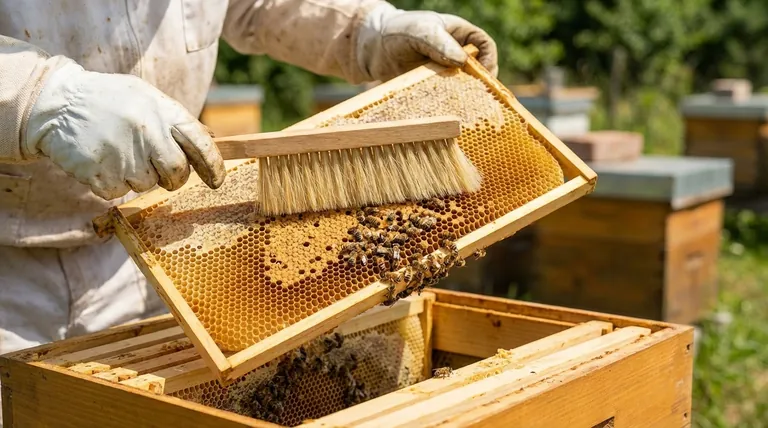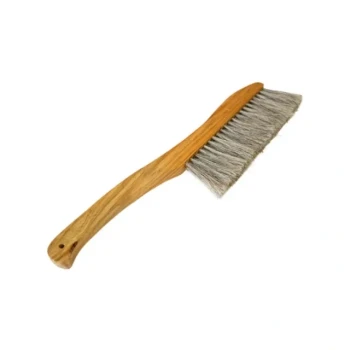In short, a bee brush is a specialized tool used to gently sweep bees off a honeycomb frame without harming them. Its purpose is to allow a beekeeper to move bees safely and precisely during hive inspections or when harvesting honey, ensuring the safety of both the beekeeper and the bees.
The core function of a bee brush is to provide gentle, precise control over bee placement. While indispensable for delicate tasks, it is often too slow for large-scale work, where alternative methods may be more efficient.

Key Scenarios for Using a Bee Brush
A bee brush is not just a simple brush; it's a tool for specific situations where care and precision are paramount.
For Detailed Hive Inspections
During a routine check, you may need a clear view of the brood pattern, to search for eggs, or to locate the queen. A bee brush allows you to gently move a small group of bees aside to see the comb beneath them.
This minimizes disruption to the colony's work and reduces the risk of angering the bees, which can happen with more aggressive removal methods.
For Small-Scale Honey Harvesting
When you are ready to harvest honey, the frames must be cleared of bees before being transported. The brush is excellent for clearing bees from one frame at a time.
You can gently sweep the bees from the frame back into the super or at the hive entrance, ensuring the frame is clear before you place it in a sealed box.
For Guiding Stray Bees
Occasionally, bees will land on your suit, equipment, or in places where they shouldn't be. A light flick with a bee brush can safely guide them back toward the hive entrance without causing them injury or provoking a sting.
Understanding the Trade-offs
Using a bee brush is a deliberate choice. While it excels at being gentle, it is not always the most efficient tool for the job.
The Brush: Gentle but Slow
The primary benefit of a brush is that it is the gentlest method available. However, as a direct consequence, it is also very time-consuming.
Brushing every bee off multiple frames or entire honey supers can take a significant amount of time, prolonging the period the hive is open and exposed.
The Alternative: Shaking
A common alternative is to hold the frame firmly over the hive and give it a sharp, downward shake. This dislodges most of the bees at once.
This method is much faster than brushing but is also more disruptive and aggressive. It can agitate the colony and risks injuring the queen if she is on the frame.
The Alternative: Blowing
For large-scale commercial operations, beekeepers often use a bee blower, which is essentially a specialized leaf blower.
This is the fastest method for clearing entire boxes (supers) of bees but requires expensive equipment and is far too aggressive for routine inspections or small-scale beekeeping.
What to Look for in a Bee Brush
A quality bee brush is designed with the bee's safety in mind.
Soft, Natural Bristles
The most critical feature is the bristles. They must be extremely soft to avoid damaging the bees' delicate wings or legs. Long, flexible bristles are ideal.
Durable and Washable Handle
A good brush will have a solid, comfortable handle, often made of wood. Because honey is sticky and equipment must be kept clean to prevent disease transmission, the brush should be easily washable in hot water.
Choosing the Right Method for Your Goal
Selecting the correct technique depends entirely on your immediate objective.
- If your primary focus is a calm, detailed inspection: The bee brush is the perfect tool for precise, gentle work.
- If your primary focus is harvesting a small number of frames: A brush offers a safe and gentle method, though a combination of shaking and brushing is also effective.
- If your primary focus is large-scale honey harvesting: The bee brush is too inefficient; methods like shaking or using a bee blower are necessary.
Ultimately, understanding your tools allows you to work with your bees in the most effective and harmonious way possible.
Summary Table:
| Scenario | Best Tool | Why? |
|---|---|---|
| Detailed Hive Inspection | Bee Brush | Gentle, precise, minimizes bee agitation |
| Small-Scale Honey Harvest | Bee Brush or Shake & Brush Combo | Safe for bees, effective for few frames |
| Large-Scale Honey Harvest | Bee Blower or Shaking | Fast, efficient for clearing many supers |
Need the Right Beekeeping Equipment for Your Apiary?
A gentle bee brush is essential for precise work, but efficient honey harvesting requires a full suite of reliable tools. HONESTBEE supplies commercial apiaries and beekeeping equipment distributors with high-quality, durable beekeeping supplies through our wholesale-focused operations.
Let us equip you for success. Contact our team today to discuss your specific needs and how we can support your operation's growth and efficiency.
Visual Guide

Related Products
- Classic Wooden Bee Brush with Double-Row Boar Bristles
- Wooden Bee Brush with Double-Row Horsehair Bristles
- Plastic Handle Single Row Artificial Fiber Bee Brush
- Wooden Bee Brush with Triple Row Artificial Fiber for Beekeeping
- Double Row Artificial Fiber Bee Brush for Beekeeping
People Also Ask
- Why is a bee brush important? Essential for Gentle, Safe Hive Management
- Why do beekeepers use a bee brush? The Essential Tool for Gentle Bee Handling
- What are the characteristics of the bristles on a bee brush? Designed for Gentle Persuasion, Not Force
- What is a bee brush and how is it used in beekeeping? A Guide to Gentle Bee Handling
- What is the purpose of a bee brush? Gently Manage Your Hive with Precision



















